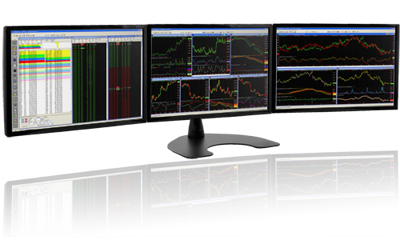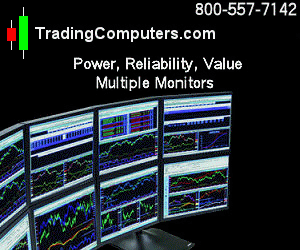|
|
Time Frame
- Scalping
- Day Trading
- Swing Trading
- Active Investing
|
 |
Scalping
Scalping is trading on very short time frames, like 4-10 minutes. The profits are much smaller but more frequent. Scalping suffers from the fact that the
fees paid to your broker will usually take a big percentage of your total profits. To be successful at scalping you need to have more than an 80% winning
percentage. This sounds impossible but I have done it and so have others. However, even at 80% winners I only cleared about $20 net profit after 40 trades
due to the effect of trading costs and the 20% of losers (losers are usually bigger than winners to get to 80%+). Traders who scalp are probably better
served by other trading methods but are either too impatient to wait longer or they prefer the excitement of this type of trading.
Day Trading
Day trading is the buying and selling of securities on the same day such that at the end of the day your account is back in cash with no positions carried
overnight. Day trading is common and many people have achieved financial independence with it. Scalping (mentioned above) is a type of very short term
day trading. Many day traders are breakeven traders because they don't manage losers properly and they fail to let winners reach proper profitability
(we will discuss this more later). In my experience day trading is the least risky (no overnight risk) and most profitable (percent profit per day)
of the time frames but it may take you a while (months/years) to master it.
You should always paper trade for a long time and then slowly transition to real money by alternating
real and paper money. Also, the first year that you do real money you should keep you trade size small because large trade sizes will be psychologically
difficult. If you go to real money too soon or you increase your trade size too soon then you will trade like scared money, which will lose you money.
Not practicing with paper money and scaling up the real money trade size too soon is the most common cause of traders failing (in my opinion). If you
are jobless and think that you can use your last little bit of money to become a day trader then forget it, that is too much pressure. Set the money aside
and stabilize your living situation first, then start to learn without that pressure.
Swing Trading
Swing trading of stocks is the most common of trading styles and the one where new traders often find the greatest early success. In swing trading you hold most
positions overnight and for several nights, weeks, or even months (but not years). It is very useful for retired people who have a substantial amount invested.
To make a living by swing trading you should have more than $150,000 to trade with. Returns of more than 20% per year are hard to achieve consistently unless
you are good at boosting your swing trading with the selling of options. You should plan on making no more than 15% per year after you are good
at it. Once you have a track record of more than two years then you can use that to plan your budget. You can also mix in a little day trading to improve your
income.
Active Investing
Active investing is where you hold positions for long periods of time for purely fundamental reasons and do not try to cash in on the ups and downs of the
market. In active investing you monitor the health of your holding and make revisions as needed to stay with the best stocks. It is the type most commonly
advocated by typical Wall Street types and yields a rate of return generally below 11% per year.
Position Trading
Position trading of stocks is used extensively by hedge funds to manage their portfolios. It is in between swing trading and active investing in that any one
position is usually held for a long time (active investing) but there are many revisions to that position as the market prices rise and fall (swing trading).
A position trader has "core holdings" that almost never are completely sold out but he sells some of it into rallies and buys it back on subsequent dips.
Depending on your skill level you can probably get returns at least as high as in swing trading because swing
traders usually sell too soon, leaving behind additional profit that could have been made had he stayed in longer. You can also effectively hedge your long
positions with short positions or options to reduce the effect of selloffs. More on this later.
Market Neutral Trading
This is a type of swing or position trading where you seek to remove the price action in the overall market by pairs trading or being otherwise fully hedged.
Hedging is where you create an offsetting position, such as being long Walmart and short JC Penny. If Walmart is a bullish stock and JC Penny is having a
hard time then you will make money on them as the difference in value widens over time (Walmart going higher and JC Penny going lower). This strategy removes
much of the effect of the overall market fluctuations and will lower your overall return but it makes that return more reliable.
Equipment
Just a quick note on equipment here (we will discuss it more in the next part of this How to Trade trilogy). Trading software (also next section) is very
powerful stuff and there is a river of market data that will flow to your computer during the trading day such that inexpensive home and office computers are not
up to the job. You also want expandability to add more monitors later. Full time traders almost always use more than two monitors and usually six or eight. That may
seem beyond your ability to grasp now but after you have been trading for a while it will seem very natural and comfortable. Imagine driving a car with just one
window: it might work fine when you are a new driver and don't want the distractions of side and rear windows but once you are good at driving you will want all the
windows so you don't have a crash with an unseen obstacle when you are making your moves on the road. Check out the computers at
TradingComputers.com, they have what you need at reasonable prices.
Scott Tafel is the founder and principle partner in Falcon Trading Systems: computers for traders. He has been a trader
since 1999. Mr. Tafel spent 27 years working in the Nuclear power industry, principally as a Nuclear Reactor Operator.
|

|
|